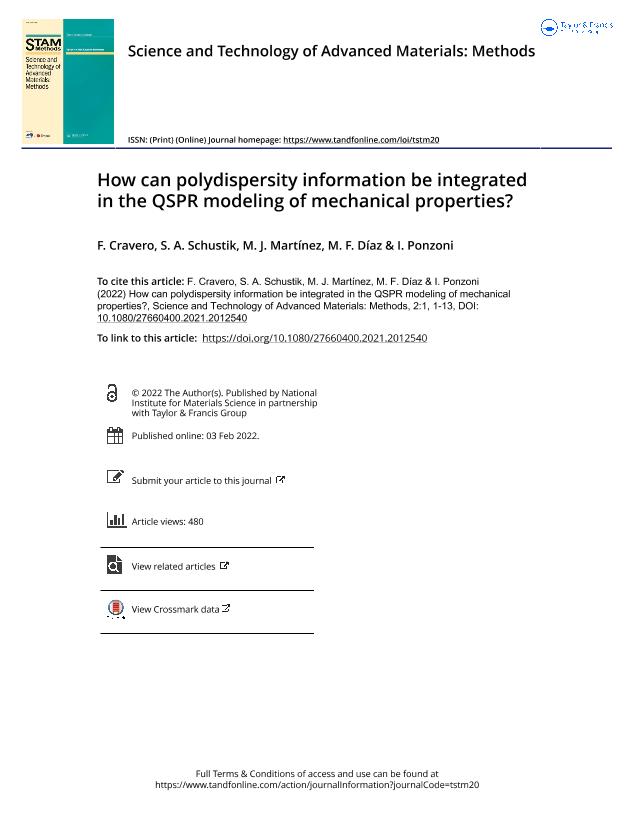Artículo
How can polydispersity information be integrated in the QSPR modeling of mechanical properties?
Cravero, Fiorella ; Schustik, Santiago; Martinez Amezaga, Nancy María Jimena
; Schustik, Santiago; Martinez Amezaga, Nancy María Jimena ; Diaz, Monica Fatima
; Diaz, Monica Fatima ; Ponzoni, Ignacio
; Ponzoni, Ignacio
 ; Schustik, Santiago; Martinez Amezaga, Nancy María Jimena
; Schustik, Santiago; Martinez Amezaga, Nancy María Jimena ; Diaz, Monica Fatima
; Diaz, Monica Fatima ; Ponzoni, Ignacio
; Ponzoni, Ignacio
Fecha de publicación:
01/2022
Editorial:
Taylor & Francis
Revista:
Science and Technology of Advanced Materials: Methods
ISSN:
2766-0400
Idioma:
Inglés
Tipo de recurso:
Artículo publicado
Clasificación temática:
Resumen
Polymer informatics is an emerging discipline that has benefited from the strong development that data science has experienced over the last decade. In particular, machine learning methods are useful to infer QSPR (Quantitative Structure Property Relationships) models that allow predicting mechanical properties related to the industrial profile of polymeric materials based on their structural repeating units (SRUs). Nonetheless, the chemical structure of the SRU is only one of the many factors that affect the industrial usefulness of a polymer. Other equally relevant factors are polymer molecular weight, molecular weight distribution, and production method, which are related to the inherent polydispersity of this kind of material. For this reason, the computational characterization used for the building of QSPR models for predicting mechanical properties should consider these main factors. The aim of this paper is to highlight recent advances in data science to address the inclusion of polydispersity information of polymeric materials in QSPR modeling. We present two dimensions of discussion: data representation and algorithmic issues. In the first one, we examine how different strategies can be applied to include polydispersity data in the molecular descriptors that characterize the polymers. We explain two data representation approaches designed by our group, named as trivalued and multivalued molecular descriptors. In the second dimension, we discuss algorithms proposed to deal with these new molecular descriptor representations during the construction of the QSPR models. Thus, we present here a comprehensible and integral methodology to address the challenges that polydispersity generates in the QSPR modeling of mechanical properties of polymers.
Palabras clave:
POLYMER INFORMATICS
,
MACHINE LEARNING
,
QSAR
,
POLYDISPERSITY
Archivos asociados
Licencia
Identificadores
Colecciones
Articulos (ICIC)
Articulos de INSTITUTO DE CS. E INGENIERIA DE LA COMPUTACION
Articulos de INSTITUTO DE CS. E INGENIERIA DE LA COMPUTACION
Articulos(ISISTAN)
Articulos de INSTITUTO SUPERIOR DE INGENIERIA DEL SOFTWARE
Articulos de INSTITUTO SUPERIOR DE INGENIERIA DEL SOFTWARE
Articulos(PLAPIQUI)
Articulos de PLANTA PILOTO DE INGENIERIA QUIMICA (I)
Articulos de PLANTA PILOTO DE INGENIERIA QUIMICA (I)
Citación
Cravero, Fiorella; Schustik, Santiago; Martinez Amezaga, Nancy María Jimena; Diaz, Monica Fatima; Ponzoni, Ignacio; How can polydispersity information be integrated in the QSPR modeling of mechanical properties?; Taylor & Francis; Science and Technology of Advanced Materials: Methods; 2; 1; 1-2022; 1-14
Compartir



